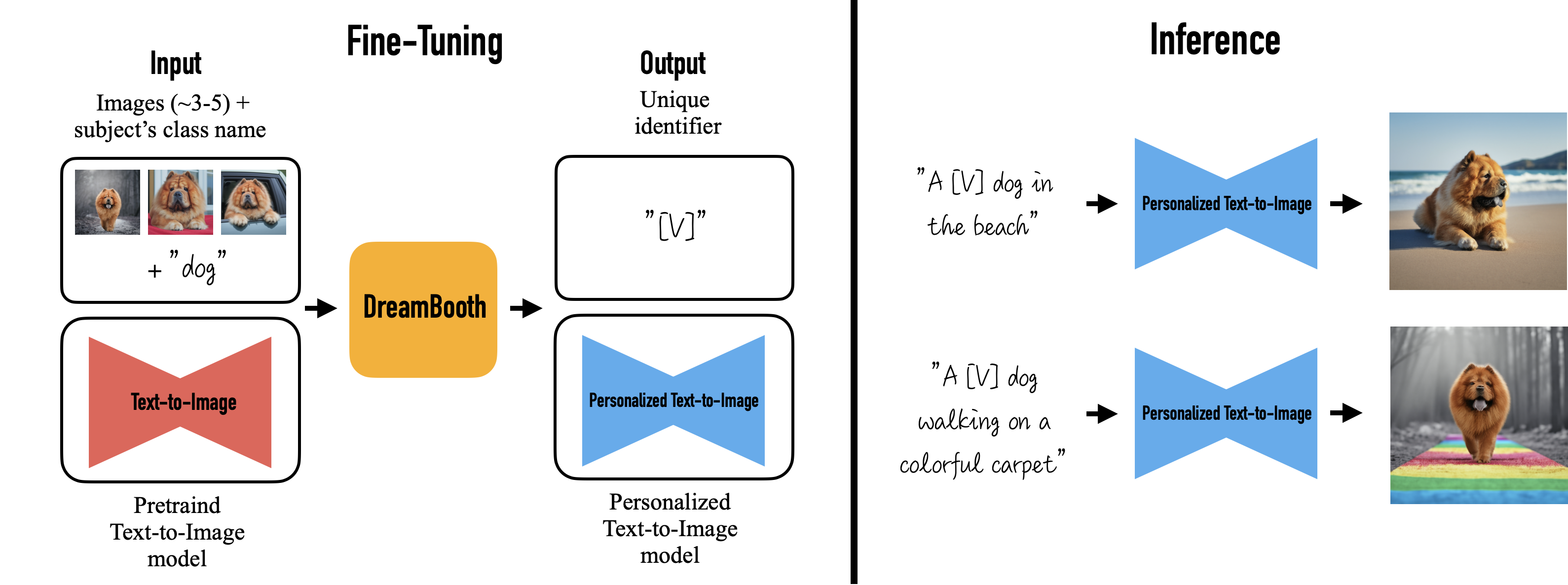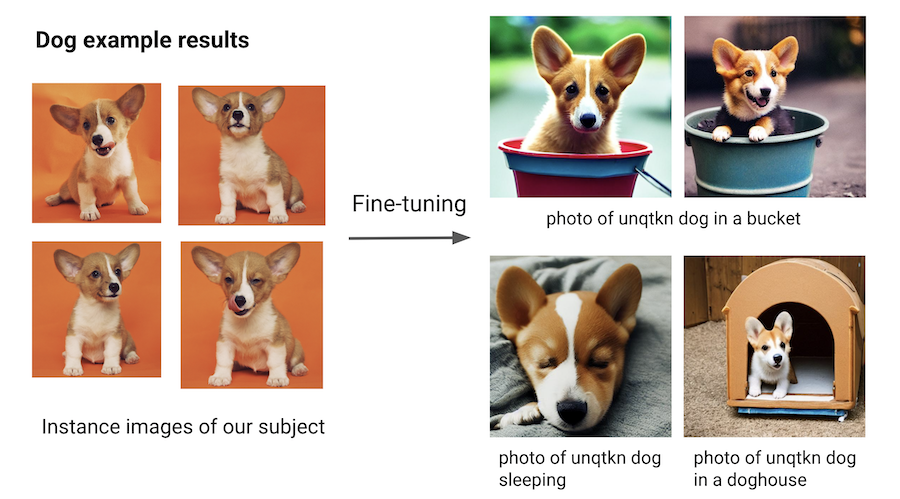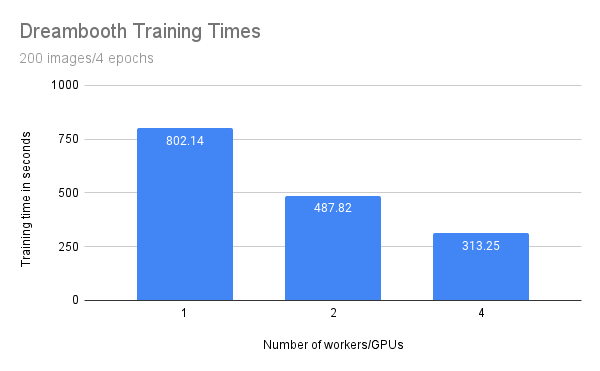使用 DreamBooth 和 Ray Train 微调 Stable Diffusion#
这是一个中级示例,展示了如何使用 Ray Train 对 Stable Diffusion 模型进行 DreamBooth 微调。它演示了如何在 Ray Train 中结合使用 Ray Data 和 PyTorch Lightning。
有关此微调方法实现的更多详细信息,请参阅原始 DreamBooth 项目主页。

此示例基于 这个 Hugging Face 🤗 教程 。请参阅 Hugging Face 教程以获取有关超参数的有用解释和建议。将此示例适配到 Ray Train 允许您轻松地将微调扩展到任意数量的分布式训练工作者。
计算要求:
由于模型尺寸较大,您需要至少配备1个A10G GPU的机器。
每个训练工作器使用1个GPU。您可以使用多个GPU或工作器来利用数据并行训练以加快训练时间。
此示例针对先验保持损失,微调了稳定扩散过程中使用的 text_encoder 和 unet 模型。

在 ray-project/ray 找到完整的代码库
工作原理#
此示例使用 Ray Data 进行数据加载,使用 Ray Train 进行分布式训练。
数据加载#
使用 Ray Data 进行数据加载。代码有三个有趣的部分。
首先,使用 ray.data.read_images() 加载两个数据集:
instance_dataset = read_images(args.instance_images_dir)
class_dataset = read_images(args.class_images_dir)
然后,对生成这些图像的提示进行分词:
tokenizer = AutoTokenizer.from_pretrained(
pretrained_model_name_or_path=args.model_dir,
subfolder="tokenizer",
)
def _tokenize(prompt):
return tokenizer(
prompt,
truncation=True,
padding="max_length",
max_length=tokenizer.model_max_length,
return_tensors="pt",
).input_ids.numpy()
# Get the token ids for both prompts.
class_prompt_ids = _tokenize(args.class_prompt)[0]
instance_prompt_ids = _tokenize(args.instance_prompt)[0]
最后,对图像应用 torchvision 预处理管道:
transform = transforms.Compose(
[
transforms.ToTensor(),
transforms.Resize(
image_resolution,
interpolation=transforms.InterpolationMode.BILINEAR,
antialias=True,
),
transforms.RandomCrop(image_resolution),
transforms.Normalize([0.5], [0.5]),
]
)
def transform_image(
batch: Dict[str, np.ndarray], output_column_name: str
) -> Dict[str, np.ndarray]:
transformed_tensors = [transform(image).numpy() for image in batch["image"]]
batch[output_column_name] = transformed_tensors
return batch
在最后一步中应用所有三个部分:
# For each dataset:
# - perform image preprocessing
# - drop the original image column
# - add a new column with the tokenized prompts
instance_dataset = (
instance_dataset.map_batches(
transform_image, fn_kwargs={"output_column_name": "instance_image"}
)
.drop_columns(["image"])
.add_column("instance_prompt_ids", lambda df: [instance_prompt_ids] * len(df))
)
分布式训练#
训练代码的核心部分是 训练函数。该函数接受一个包含超参数的配置字典。然后定义一个常规的 PyTorch 训练循环。
你只需在以下代码片段中的几个位置与 Ray Train API 进行交互,这些位置在代码中通过行内注释标明。
记住,你想要对所有模型进行数据并行训练。
使用
session.get_dataset_shard("train")`为每个工作器加载数据分片使用
train_dataset.iter_torch_batches()`遍历数据集使用
session.report(results)`向 Ray Train 报告结果
代码为简洁起见进行了压缩。完整代码 有更详细的注释。
def train_fn(config):
# Load pre-trained models.
(
text_encoder,
noise_scheduler,
vae,
unet,
unet_trainable_parameters,
text_trainable_parameters,
) = load_models(config)
text_encoder = train.torch.prepare_model(text_encoder)
unet = train.torch.prepare_model(unet)
# manually move to device as `prepare_model` can't be used on
# non-training models.
vae = vae.to(train.torch.get_device())
# Use the regular AdamW optimizer to work with bfloat16 weights.
optimizer = torch.optim.AdamW(
itertools.chain(unet_trainable_parameters, text_trainable_parameters),
lr=config["lr"],
)
train_dataset = train.get_dataset_shard("train")
# Train!
num_train_epochs = config["num_epochs"]
print(f"Running {num_train_epochs} epochs.")
global_step = 0
for _ in range(num_train_epochs):
if global_step >= config["max_train_steps"]:
print(f"Stopping training after reaching {global_step} steps...")
break
for _, batch in enumerate(
train_dataset.iter_torch_batches(
batch_size=config["train_batch_size"],
device=train.torch.get_device(),
)
):
batch = collate(batch, torch.bfloat16)
optimizer.zero_grad()
# Convert images to latent space
latents = vae.encode(batch["images"]).latent_dist.sample() * 0.18215
# Sample noise that we'll add to the latents
noise = torch.randn_like(latents)
bsz = latents.shape[0]
# Sample a random timestep for each image
timesteps = torch.randint(
0,
noise_scheduler.config.num_train_timesteps,
(bsz,),
device=latents.device,
)
timesteps = timesteps.long()
# Add noise to the latents according to the noise magnitude at each timestep
# (this is the forward diffusion process)
noisy_latents = noise_scheduler.add_noise(latents, noise, timesteps)
# Get the text embedding for conditioning
encoder_hidden_states = text_encoder(batch["prompt_ids"])[0]
# Predict the noise residual.
model_pred = unet(
noisy_latents.to(train.torch.get_device()),
timesteps.to(train.torch.get_device()),
encoder_hidden_states.to(train.torch.get_device()),
).sample
target = get_target(noise_scheduler, noise, latents, timesteps)
loss = prior_preserving_loss(
model_pred, target, config["prior_loss_weight"]
)
loss.backward()
# Gradient clipping before optimizer stepping.
clip_grad_norm_(
itertools.chain(unet_trainable_parameters, text_trainable_parameters),
config["max_grad_norm"],
)
optimizer.step() # Step all optimizers.
global_step += 1
results = {
"step": global_step,
"loss": loss.detach().item(),
}
train.report(results)
if global_step >= config["max_train_steps"]:
break
然后,您可以使用 Ray Train 的 TorchTrainer 运行此训练函数:
args = train_arguments().parse_args()
# Build training dataset.
train_dataset = get_train_dataset(args)
print(f"Loaded training dataset (size: {train_dataset.count()})")
# Train with Ray Train TorchTrainer.
trainer = TorchTrainer(
train_fn,
train_loop_config=vars(args),
scaling_config=ScalingConfig(
use_gpu=True,
num_workers=args.num_workers,
),
datasets={
"train": train_dataset,
},
)
result = trainer.fit()
配置比例#
在 TorchTrainer 中,您可以轻松配置规模。前面的示例使用 num_workers 参数来指定工作者的数量。此参数默认设置为每个工作者 1 个 GPU,总共 2 个 GPU。
要在4个GPU上运行示例,请使用 --num-workers=4 将工作线程数设置为4。或者您可以直接更改扩展配置:
scaling_config=ScalingConfig(
use_gpu=True,
- num_workers=args.num_workers,
+ num_workers=4,
)
如果你正在进行多节点训练,请确保所有节点都能访问共享存储,如NFS或EFS。在下面的示例脚本中,你可以使用``DATA_PREFIX``环境变量调整位置。
训练吞吐量#
比较使用1、2和4个工作节点或GPU的前一次训练运行的吞吐量。
考虑以下设置:
1 个 GCE g2-standard-48-nvidia-l4-4 实例,配备 4 个 GPU
按如下配置的模型
Data from this example
200 regularization images
训练4个周期(本地批次大小 = 2)
每种配置3次运行
你期望训练时间应受益于规模,并且在使用更多工作节点和GPU时减少。

工作线程/GPU 数量 |
训练时间(秒) |
|---|---|
|
802.14 |
2 |
487.82 |
4 |
313.25 |
虽然训练时间随着工作节点/GPU数量的增加而线性减少,但你可以观察到一些惩罚。具体来说,当工作节点数量翻倍时,训练时间并不会减半。
这种惩罚很可能是由于进程间额外的通信和大型模型权重的传输。由于GPU内存限制,您也仅以批量大小为1进行训练。在具有更大批量的高端GPU上,您会期望从扩展中获得更大的好处。
运行示例#
首先,下载预训练的 Stable Diffusion 模型作为起点。
然后使用几张主题图片来训练这个模型。
要实现这一点,选择一个非单词作为标识符,例如 unqtkn。当使用这个主题进行微调时,你教会模型提示是 A photo of a unqtkn <class>。
微调后,您可以使用此特定提示进行推理。例如:A photo of a unqtkn <class> 会生成该主题的图像。同样,A photo of a unqtkn <class> at the beach 会生成该主题在海滩上的图像。
步骤 0:准备#
克隆 Ray 仓库,进入示例目录,并安装依赖项。
git clone https://github.com/ray-project/ray.git
cd doc/source/templates/05_dreambooth_finetuning
pip install -Ur dreambooth/requirements.txt
准备一些目录和环境变量。
# TODO: If running on multiple nodes, change this path to a shared directory (ex: NFS)
export DATA_PREFIX="/tmp"
export ORIG_MODEL_NAME="CompVis/stable-diffusion-v1-4"
export ORIG_MODEL_HASH="b95be7d6f134c3a9e62ee616f310733567f069ce"
export ORIG_MODEL_DIR="$DATA_PREFIX/model-orig"
export ORIG_MODEL_PATH="$ORIG_MODEL_DIR/models--${ORIG_MODEL_NAME/\//--}/snapshots/$ORIG_MODEL_HASH"
export TUNED_MODEL_DIR="$DATA_PREFIX/model-tuned"
export IMAGES_REG_DIR="$DATA_PREFIX/images-reg"
export IMAGES_OWN_DIR="$DATA_PREFIX/images-own"
export IMAGES_NEW_DIR="$DATA_PREFIX/images-new"
# TODO: Add more worker nodes and increase NUM_WORKERS for more data-parallelism
export NUM_WORKERS=2
mkdir -p $ORIG_MODEL_DIR $TUNED_MODEL_DIR $IMAGES_REG_DIR $IMAGES_OWN_DIR $IMAGES_NEW_DIR
步骤 1:下载预训练模型#
在本地下载并缓存预训练的 Stable Diffusion 模型。
python cache_model.py --model_dir=$ORIG_MODEL_DIR --model_name=$ORIG_MODEL_NAME --revision=$ORIG_MODEL_HASH
您可以在 $ORIG_MODEL_PATH 访问下载的模型检查点。
步骤 2:提供您主题的图片#
使用其中一个示例数据集,如 dog 或 lego car,或者提供您自己的图像目录,并使用 $INSTANCE_DIR 环境变量指定该目录。
然后,将这些图像复制到 $IMAGES_OWN_DIR。
# Only uncomment one of the following:
# Option 1: Use the dog dataset ---------
export CLASS_NAME="dog"
python download_example_dataset.py ./images/dog
export INSTANCE_DIR=./images/dog
# ---------------------------------------
# Option 2: Use the lego car dataset ----
# export CLASS_NAME="car"
# export INSTANCE_DIR=./images/lego-car
# ---------------------------------------
# Option 3: Use your own images ---------
# export CLASS_NAME="<class-of-your-subject>"
# export INSTANCE_DIR="/path/to/images/of/subject"
# ---------------------------------------
# Copy own images into IMAGES_OWN_DIR
cp -rf $INSTANCE_DIR/* "$IMAGES_OWN_DIR/"
$CLASS_NAME 应是你主题的总体类别。由提示 photo of a unqtkn <class> 生成的图像应是多样化的图像,这些图像与主题有足够的差异,以便生成的图像能清晰地展示微调的效果。
步骤 3:创建正则化图像#
使用预训练的稳定扩散模型为某一类主题创建一个正则化图像集。这个正则化集确保模型仍然能为同一类的随机图像生成不错的图像,而不仅仅是优化生成主题的好图像。
python generate.py \
--model_dir=$ORIG_MODEL_PATH \
--output_dir=$IMAGES_REG_DIR \
--prompts="photo of a $CLASS_NAME" \
--num_samples_per_prompt=200 \
--use_ray_data
使用 Ray Data 以 4 个工作线程进行批量推理,以并行生成更多图像。
步骤 4:微调模型#
在本地目录中保存几张(例如4到5张)正在微调的主题图像。然后使用以下命令启动训练任务:
python train.py \
--model_dir=$ORIG_MODEL_PATH \
--output_dir=$TUNED_MODEL_DIR \
--instance_images_dir=$IMAGES_OWN_DIR \
--instance_prompt="photo of $UNIQUE_TOKEN $CLASS_NAME" \
--class_images_dir=$IMAGES_REG_DIR \
--class_prompt="photo of a $CLASS_NAME" \
--train_batch_size=2 \
--lr=5e-6 \
--num_epochs=4 \
--max_train_steps=200 \
--num_workers $NUM_WORKERS
步骤 5:生成主题的图像#
使用与步骤2相同的命令行尝试您的模型,但这次指向您自己的模型。
python generate.py \
--model_dir=$TUNED_MODEL_DIR \
--output_dir=$IMAGES_NEW_DIR \
--prompts="photo of a $UNIQUE_TOKEN $CLASS_NAME in a bucket" \
--num_samples_per_prompt=5
接下来,尝试用更有趣的内容替换提示。
例如,对于狗的主题,你可以尝试:
photo of a unqtkn dog in a bucket“一只 unqtkn 狗睡觉的照片”
photo of a unqtkn dog in a doghouse
另见#
Ray Train 示例 了解更多用例
Ray Train 用户指南 提供了操作指南